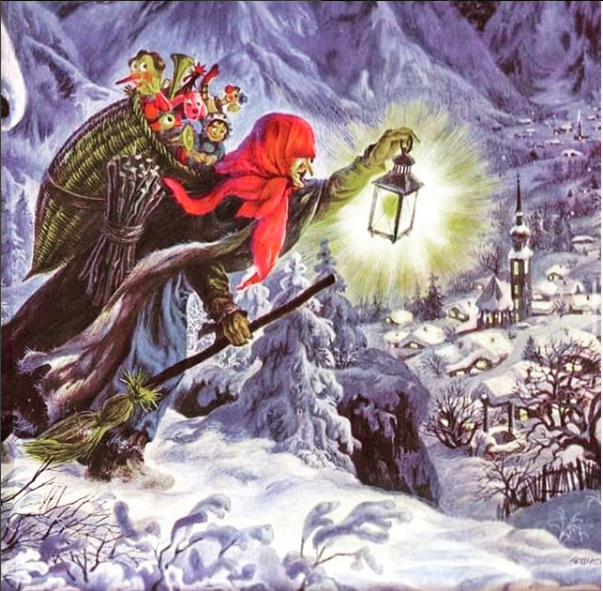The 7th day of Yuletide: The Christmas Witch
Ever heard of La Befana? She comes from an Italian legend connected to the birth of Jesus. La Befana's name is derived from the Greek word for Epiphany. The Epiphany is the day baby Jesus was revealed as the Son of God. The legend says the Three Magi stopped at La Befana’s home on their way to find the baby Jesus. She is described as an ugly, poor, old woman with a broom (recall the Cailleach of the Celts). The witch receives the three Magi. In some legends they asked her for directions and she points to the star of Bethlehem. In others, they are already following the star and invite her to come along.
Ever heard of La Befana? She comes from an Italian legend connected to the birth of Jesus. La Befana's name is derived from the Greek word for Epiphany. The Epiphany is the day baby Jesus was revealed as the Son of God. The legend says the Three Magi stopped at La Befana’s home on their way to find the baby Jesus. She is described as an ugly, poor, old woman with a broom (recall the Cailleach of the Celts). The witch receives the three Magi. In some legends they asked her for directions and she points to the star of Bethlehem. In others, they are already following the star and invite her to come along. La Befana refuses because she has too much sweeping to do, but after they leave she changes her mind. She tries to follow them without luck, and to this day, she wanders the skies on her broom looking for baby Jesus. At each home she flies down chimneys and leaves gifts for good children or coal for bad children.
Prior to Santa Claus, the only gift-giver at this time of year in Southern Italy was La Befana. She too, has older roots than her encounter with the Three Magi. In pre-Christian Italy, there was a tradition burning an effigy of an old lady to bring in the new year. Pieces of that fire, as well as the sacred ceppo, or Yule log, were represented in her gifts of fertility now known as "lumps of" coal. Lift up any tradition and there is another one that is Earth honouring, and perhaps a little more female honouring hiding underneath it.
Midwinter was considered a time when witches and ancestral spirits could most easily be felt. It was at this time that stories were told and divinations were cast. It was time for magic and divination. Who better to represent this time than a benevolent witch who somehow found her way into Christian myth. The broom is one of the most powerful symbols of Old European women’s spirituality. It is the symbol of the spirit flight of the shaman, or witch, or seer. It is the world tree. It is the spine, the Axis Mundi, the sacred tool. It is a women's spiritual heritage hidden in plain sight.
Witches? Why, Thank You.
I don’t speak on Halloween. I don't write. I honour my ancestors. It’s an exercise in liminality. I’ve been doing this since I was 15. Last night, a group of female friends and I decided to dress up all in white, paint our faces white, and pass candy out to kids.
I don’t speak on Halloween. I don't write. I honour my ancestors. It’s an exercise in liminality. I’ve been doing this since I was 15. Last night, a group of female friends and I decided to dress up all in white, paint our faces white, and pass candy out to kids. All this, while seated in a semicircle, silent. See, the town that my sisters and I evacuated to during the fires happens to be THE BEST town for halloween. Over a thousand trick or treater’s passed by the house where we held our silent counsel. ⠀
When you don’t speak on halloween, people like to guess what you are. It’s become half the fun for me. ⠀
We got a lot of good guesses: zombies, ghosts, ghost-brides, but what most people called us? Witches. Oracles. “Are you going to tell me my future?” “Are you the Oracle of Delphi.” “Look at the witches!”⠀
We weren’t wearing pointy hats. We didn’t have broomsticks. For goodness sake, we were trying to be creepy. Yet deep in the human psyche there is a recognition of feminine power. How could there not be? Women were spiritual leaders, shamans, priestesses and prophetesses for much longer than the genocidal claws of Christianisation. When every aspect of our spiritual and religious authority was stripped from us, we still found a way to hide it in our weaving, our cooking, our storytelling, our songs. ⠀
Witches you say? Yes. We’ll take it. Witches. Wyrd Women. Fates. Spinners. Pythonissa. Incantrix. Fee. Hag. All the different ways to say world-weaver, healer, woman who walks the edge places. Hedge-woman. Truth-speaker. Poet-prophet. Way-finder. Midwife. Night-Farer. Shapeshifter. Banfáith. Fate-seeress. Divina. Mystery-singer. Strega. Pharmakis. Blesser. Bruja. Heathen.⠀
Five women, clad in white, holding silence on the eve of the ancient heathen new year? Witches, you decide, as you gather candy from a basket. This is because something in you, no matter how deeply buried says “This. I recognise this. I know this. She is power. She is prophecy. She is not forgotten.”⠀




